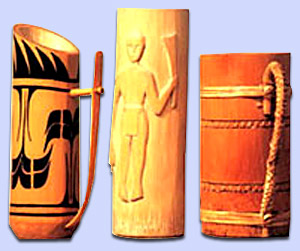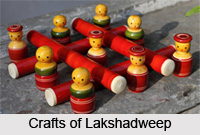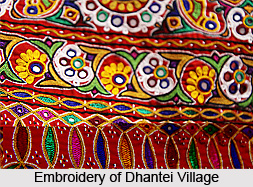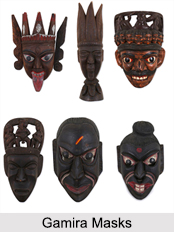 Wooden masks are made with variety of motifs, shapes, sizes and colours based on the location they originate from. Among the masks of West Bengal, Gamira masks or gilded masks of Kushmandi, Shiknidhal mask, Gambhira dance masks, Bagpa dance masks are made up of wood. The masks have been used since antiquity for both ceremonial and practical purposes.
Wooden masks are made with variety of motifs, shapes, sizes and colours based on the location they originate from. Among the masks of West Bengal, Gamira masks or gilded masks of Kushmandi, Shiknidhal mask, Gambhira dance masks, Bagpa dance masks are made up of wood. The masks have been used since antiquity for both ceremonial and practical purposes.
Wooden Masks of West Bengal
The wooden masks mentioned above, are detailed elaborately below:
Gamira Mask: Gamira mask is a part of Gomira dance which is originated in South and North Dinajpur districts of West Bengal. Gamira mask is the ecstatic wooden mask of Kushmandi, which is primarily associated with the Rajbangshi community of the area. The word Gamira is colloquial from Gram-Chandi, who is a female goddess. The exact origin of this craft is no doubt very old and some of the craftsmen claim it is at least as old as the beginning of kaliyug. The wood-crafted Gamira mask represents two distinct forms. The characters of two distinct forms of the dance are the Gamira and the Ram-Vanwas. The scary masks of the Gamira are made from the wood of the Gamar tree. Holes are made under the eyes of the mask for the wearer to see.
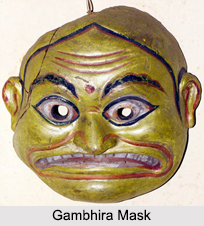 The makers of these masks are mainly from the village of Mahisbathan, where a handicraft hub has been developed as a part of rural craft hub. This initiative has been taken by the MSME department of Government of West Bengal in collaboration with UNESCO. At first, the artist prepares a model from mashed paper layered upon a piece of cloth soaked in mud water. After drying the cloth, it is topped with sponge wood and coloured. For the glow, it is given a varnish polish on the mask and decorated with sequences, foil and coloured paper. The Gamira dances are organized to worship the goddess and welcome the good forces and drive out the evil forces. The mask dance takes place between mid- April to mid-July.
The makers of these masks are mainly from the village of Mahisbathan, where a handicraft hub has been developed as a part of rural craft hub. This initiative has been taken by the MSME department of Government of West Bengal in collaboration with UNESCO. At first, the artist prepares a model from mashed paper layered upon a piece of cloth soaked in mud water. After drying the cloth, it is topped with sponge wood and coloured. For the glow, it is given a varnish polish on the mask and decorated with sequences, foil and coloured paper. The Gamira dances are organized to worship the goddess and welcome the good forces and drive out the evil forces. The mask dance takes place between mid- April to mid-July.
Shiknidhal Mask: This gigantic wooden mask is also used in the Gomira dance in South Dinajpur portion. This mask is used for the war dance. It is also called Mukha Khel, which means the game of masks. In 2013, a memorandum of understanding was signed between the West Bengal government and UNESCO to promote culture-based livelihoods, for which things are getting better for the mask makers.
Gambhira Mask: The Gambhira dance is performed all over the Malda district of North Bengal during the festival of Chaitra Sankranti. The masks are made out of neem and fig trees by the local Sutradhar community. Sometimes the masks are also made out of clay, but that is very rare. The masks are actually three-dimensional crowns, which is the specialty of it. First, the facial features are carved out from a piece of wood and then coloured according to the character. This mask dance is performed with Gambhira song. The songs of Gambhira have been originated from the Hindu community of Maldah.
Bagpa Mask: Bagpa mask is used for Bagpa dance, which is a part of tantrik Buddhism. It was conceptualised by Guru Padmashambhava. The masks are used for war dance based on the theme of the destruction by evil and for the well-being of humanity. Bagpa masks are colourful wooden masks; they generally are red, blue and white in colour. Other colors are used for detailing the mask.
The concept of mask making was primarily meant to provide masks for religious functions, folk theatres and folk dance, but now in regular life, masks hold a special significance.



